Page Updated 7 Jan. 2021.
To make sure you are seeing the latest version of this or any web page and not an older "cached" version, click the icon at the top of your browser for "refresh" or "reload". It is a little "C" button with an arrow at the top end of the C. In Internet Explorer it is about the middle of the top of your screen while in Google's "Chrome" browser it is near the left. (In older versions of browsers it was on the right under Tools.)
We begin this web page by ratcheting back to the end of WWII. A handful of 1945 Chiefs were made, identical to the prewar ones. The 1946-48 Chiefs sold very well but were barely improved from the prewar ones. The front fork from the Army model 841 replaced the very crude and very heavy "half leaf spring" on the front. Unlike the Chief the very popular flathead Scout was not revived after the war (except for a small batch released to racers in 1948). The idea was that it would be replaced by the new Torque series (213 c.c single advertised as 220 and 426 cc. advertised as 440 cc) loosely copied from English bikes such as Triumph which had impressed US servicemen stationed in Britain during the war. Expecting the new short stroke OHV twins with their hand operated clutches, 4 speed foot shifts and light weight made sense on paper but it was a disaster. Because the "Torque" was rushed into production with many serious reliability issues, and because it was very small, about 15 - 20% smaller in overall size than comparable British bikes and way smaller than the big American V twins. (Not to mention that 426 cc was 15% smaller than most British twins.) Reliability problems were pretty much cured by 1950 and the displacement was upped to 500 c.c. and the name changed from Scout to Warrior and a better paint job, but by then the reputation was ruined, V twin flathead Scout lovers gave up on Indian, and so the Torque series ended around 1951. (One sees the occasional 1952 for sale, perhaps these were unsold 1951's relabelled .) Image below is of a 1951 Warrior with a Harley windshield and chromed oil tank and forks and 1960's paint similar to Harley's Hi-Fi blue. To understand how small the bike is, look at the windshield which looks so big but just right for a Harley of 1200 c.c. Underneath is an exploded diagram of the 1949 engine

Meanwhile the competition was fierce, not only from the 500 cc (later 650 and 750 cc) British imports, but domestic competition from Indian's main rival in the big V twin market, Harley-Davidson. Harley was still selling a bike very similar to the Chief, its 1200 later 1300 c.c. U, UL and ULH models (see image below of a 1948 UL, the primary chaincase has been chromed, should be black.)
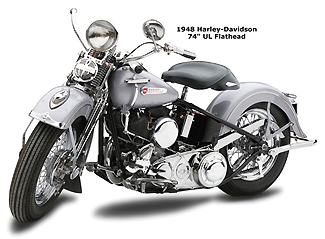
However, Harley had introduced its valve-in-head (OHV) Knucklehead in 1936 and sales resumed after the war. This bike was more powerful than any flathead of similar or somewhat larger displacement. Image below is of a 1946 "knucklehead". The actual name was EL for the original 1 liter versions and FL for the later postwar 1200 c.c. versions.
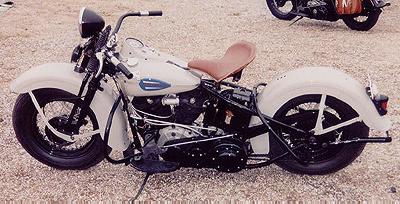
Even worse for Indian in the late 1940's, the Knucklehead engine was replaced by the somewhat more advanced and much more modern looking Panhead engine in 1948. The first year Panhead still had the crude springer front end but in 1949 that bike got telescopic-hydraulically dampened front forks similar to Indian's (which were under development in 1949 and did not appear until 1950). The 1949 "Hog" was offically called the Hydra-Glide FL. (see image below)
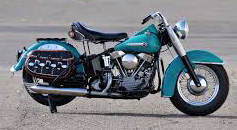

That same year that the Hydra-Glide debuted (1949) Indian had made the huge mistake of dropping its big Chief so it had absolutely nothing to compete with Harley with (the small Torque singles and twins appealed to a different market). The 1950 Chief came a year later, after many dealers and customers had complained and given up on Indian, and while the new Chief had modern forks and a 100 cc larger engine and some modern styling touches, it lacked overhead valves and a 4 speed transmission, and was "too little too late". (See image below of a 1950 Chief.)
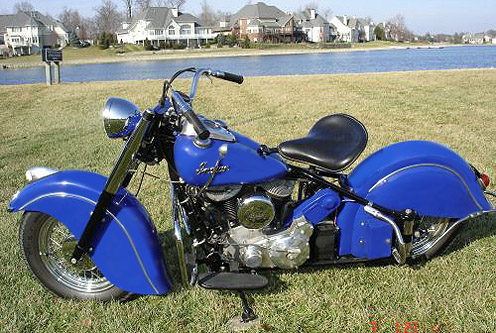
As if competition from the British singles and twins and from Harley's OHV Kucklehead and then Panhead models was not enough to send Indian reeling in the early 1950's, another punch came in 1952 Harley when came out with its own attempt to compete with the British sports bikes. It was basically a British design (in fact more advanced in that it had unit construction which Triumph and BSA did not try until a decade later) but unlike Indian who copied the typical British OHV parallel twin engine, Harley was more conservative and instead used a mini-version of its big flathead twins (or to put it another way, updated its venerable 750 flathead "45"). This new Harley sport bike was called simply the K model. The engine was more powerful than previous Harley flatheads but very disappointing compared to the British competition. (Remedied later in the decade right after Indian's demise with an 888 c.c. version 1954-56 and then the OHV version known as the Sportster.) Images show a 1952 K, very mildly and tastefully customized by painting the oil tank white and chroming the timing cover and gearbox sprocket cover. The rear fender has been chopped a few inches, as the factory did in 1969.

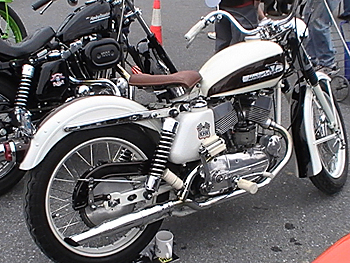
So Indian made two huge mistakes, dropping the flathead 750 c.c. Scout and "dropping the ball" with the Chief. Instead of simply updating these popular models as Harley did with theirs, Indian put all its resources into the ill-fate Torque series. (Interestingly, in the UK Ariel did the same thing exactly ten years later when in 1959 it ceased making its popular 500 singles, 650 twin and famous 1000 c.c. Square Four in favour of lightweight small c.c. bikes (and a trike) which were unreliable.) Actually in retrospect the Indian and Ariel decisions made sense insofar as Honda copied the same idea in the early 1960's, offering small bikes to a new market of non-Bikers; the main difference being the Hondas were extremely reliable and Honda was lucky as it "caught the wave" of a big motorcycle boom as Baby Boomer hit their teens and got drivers' licences and jobs. Indian and Ariel had the foresight and made the right decision too early and with shoddy products, turning a good idea into a demise. (Ariel was absorbed into BSA and production quickly ceased.),
So in 1953 the second biggest domestic maker, a company that started two years before Harley and was their main competitor, suddenly stopping producing and selling. Enthusiasts must have been even more disappointed when after the demise of the Chief and thus all American made Indians, the new British owner Brockhouse used what was left of the distribution network to sell English made motorcycles. As noted above, by the latter half of 1953 the company was bankrupt, and its shares and assets (including the intellectual property, e.g. Indian trademarks) were sold in 1954 to two different companies: the English Brockhouse Corporation - who would use the Indian dealer network to sell certain English motorycles - and to the Titeflex company who attempted unsuccessfully to manufacture things in the USA and whose name remained on the Springfield factory until wind blew it down in 2005.
Ad below is my evidence that Indian was selling Matchless as early as 1952. I
do not know if that was the first year - probably because if earlier the
Matchless (same as AJS) 500 cc. twins and singles would have competed with
Indian's home made "torque" Scouts. It must have been embarrassing for Indian
dealers to find themselves a few years later selling the competition (British
twins) under the Indian label after their supposed own Brit-beater failed.
I gather from the old ads I have collected that the first Matchless/AJS arrangement with Indian lasted only three years inclusive (1952-54) as in 1955 the Indian sales organization was selling Royal Enfields. This was also short lived as only five years later in 1960 Associated Motor Cycles of the UK (makers of Matchless and Norton) bought Indian and so Indian reverted to selling Matchlesses in the USA and the Enfields were cancelled except for the 700 cc Chief version. As can be seen from the ads reproduced in this website (and described below) Indian was definitely selling Matchlesses in 1960, '61 and '62 (but since AMC owned Indian this is a bit misleading). This second marriage to Matchless also only lasted three years. Ads for 1960 and '61 are shown in this website. As for 1962, I just came across a Cycle magazine which shows in a 1/3 page ad the Enfield Chief still being advertised in May 1962, but this ad does not appear in the latter half of that year. In that May ad the Indian script logo is larger than the Flying M Matchless logo. The Indian name still had some cache back then. However it was fast fading, at least in the eyes of the new owners from England. In the July ad the logos are now about the same size. By the Oct. issue the Matchless logo is much bigger than the Indian one and the word MATCHLESS appears three times in the ad. This suggests that Matchless was doing well but but instead of a photo of a MC the July and Oct. ads only show crude drawings of a motorcycle which I eventually identified as a Matchless. Specifically the full page ad in Cycle for July 1962 is roughly hand sketched and it says "Its Matchless for FUN!" and it shows a teenager showing his parents a magazine which itself shows a crude drawing of a bike but looking carefully that bike is labelled a Matchless "45" and looking more carefully it does resemble a 1962 G-15/45. Doubt any reader in 1962 would have the information and motivation to suss that out. Maybe AMC could not afford a photo of one for the ad? It ends saying "He's right, motorcycling is fun - especially on a Matchless. For the most in safety, excitement and just plain fun at any age [the father is smiling as he looks at the ad within the ad so not too old to ride himself] ride the best, ride Matchless". The bottom row of the ad says "the thing to do in '62 ... Buy MATCHLESS." To the right is a Matchless logo with the flying M and beside it the Indian head with feather logo. Under the Matchless logo it says "the Indian co." in smaller letters. Then two addresses, one of which is Massachusetts but not Springfield (the other is California) At the very bottom in small letters is "Divison of Associated Motor Cycles Ltd." The Oct. 1962 issue of Cycle has another full page ad with the very same at the bottom row. The main image is another crude drawing by the same artist of the teenager riding a bike with a buddy on the back waving to us and there is a big Flying M on the tank so i guess he bought a Matchless after seeing the earlier ad. The engine is a twin (apparently a 650 or the G15/45). The main heading is "there's a MATCHLESS for YOU!" The small type says that whether you are 16 or 60 there is a Matchless that will fit your budget. Imagine having a full page advertising campaign which only shows a crude pencil sketch of the product. Does it not convey to the reader that the company is about to go bust? The Jawa, Harley, Norton and BSA ads all show large high resolution (for the day) photos of the product. The Triumph ad shows retouched, sharp photos of a Tiger and a Bonneville and two photos of Trumpets winning races (one on and one off the road) The BMW ads are boring but at least have photos.. In fact AMC was in a long slide toward eventual bankruptcy. In 1963 Joe Berliner took over the Matchless (and Norton) importation. My 1963 Matchless ads do not mention Indian any more, only Berliner. As for Indian it seemed to have nothing to sell as of 1963, and since it was only a sales organization rather than a manufacturer it was worthless, except for the Intellectual Property (trade name and marks). I think Floyd Clymer must have bought them from AMC for a small sum around 1968. As an aside, I was legal counsel in a Canadian Federal Court case around the Indian name and 'script' logo back in 1990 and '91 when it had (we argued) fallen into the public domain. Going back to 1963 the Indian company had nothing to sell and it must have ceased to exist. In 1965 Sammy Pierce tried a revival with a few custom bobber style cycles using modified Scout flathead engines and in 1968 Floyd Clymer tried to revive the marque with a prototype of a Scout engine in a then modern, Germanic rolling chassis, and when that bizarre combinatiion of nostalgia and current technology not surprisingly failed he began using Royal Enfield 750 engines in Italian chassis in 1971 (All this in more detail much further down this web page.)
To summarize, Indian had a "marriage" with Matchless twice in a ten year period (1952 and 1960) and with Royal Enfield twice in a ten year period (1958 and in name only under Clymer in 1968)! Interestingly Royal Enfield is still in business but made in India. So it gets confusing to talk of Indian Enfields (Clymer's 1971 attempt v. the millions of Enfield motorycles made in India and more recently renamed Royal Enfield). And now that Indian has been revived in the US it must confuse many people into thinking it is made in India. Blame it on Christopher Columbus and his bad navigation and geography. But to market the US made V twin motorycles as "American Aboriginal" or "American Indigenous" or "First Nations" just does not work from a marketing perspective.
The ad below is from late 1954 and well expresses the situation the year after the original Indian company failed. When bikers read it they must have been overjoyed and thought another American made and designed Indian was on the way.
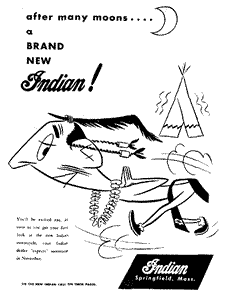
Instead the "new" 1955 series was basically just the English line of Royal Enfields painted in Indian red and bearing the Indian script on their tanks (although the Chief had its own fenders, wheels, instrument console, fishtails, braces, crashbars, spotlites, and ornaments made in USA, and an extended frame and elongated chain guard and stronger gears for police use see photos furhter down this page.). You can also visit www.re-indian.com for more details. History has shown the 700 cc models, e.g. the Trailblazers and Chiefs, to have been quite reliable. Royal Enfields were a good bike - I would say the best of the Brits and I have owned many Britbikes including a 1969 Royal Enfield - but giving them cosmetic treatments and selling them as Indians in the USA (from 1955 - 1962) must have been depressing for those expecting an updated Chief or Scout. Why didn't Indian market the Vindian which I described in the main page (1901-1953 history) of this site? That would have been a great new Indian. It would've been a Super Chief. And what about the OHV Fours and shaft drive Fours? Perhaps some thought these were the "new models" that required two years to perfect. Apparently the factory simply lacked the funds to proceed, and decided to abandon updates to old models and instead put its resources into the Torque series.
The British Royal Enfields were given North American Indian names such as Fire Arrow (250 c.c. single cylinder), Woodsman (500 c.c. single scrambler),Tomahawk ( 500 c.c. or 30.5 CID twin), Chief and Trailblazer (700 c.c. twins).
Below are two photos of a 1956 Fire Arrow. These bikes are very rare.

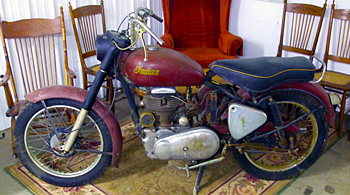
Below are two Cycle magazine full page ads from 1955 showing the Indian Trailblazer 700 c.c. (42.5 CID) twin based on the Royal Enfield Constellation. Very disappointing to someone expecting to see a full fendered Chief or Scout V-twin. On the other hand Cycle magazine testers were very impressed with its power, brakes and smoothness. When it zipped though the 1/4 mile in just over 15 seconds, they described its acceleration as "fierce". (Consider this was about 65 years ago!) Top speed was almost 110 mph. The name Trail Blazer was meant in a general sense; it did not imply "trail" as in trail or dirt bike. It was a street bike.

In Aug. 2000 I went for a three hour ride with a bunch of
Enfields and 1955-60 Indians, and one fellow had a 1955 Trail Blazer which he
had bought when new! The bike still looked new but had plenty of miles on it
after 45 years of riding. It started fine, ran like a charm, didn't weep a drop
of oil, sounded great and looked much better than these old ads would suggest.
In fact the bike is long and lean, like a 1960's Sportster, not chunky and short
as it appears in these old photos. I chose to ride just behind and to the side
of it so I could oggle it and groove off the exhaust note. It seemed to have
plenty of power for a 700 twin. There was also a 500 single Woodsman in our
group and it ran fine too. Regretably I did not take my camera to that rally.
However in Jan. 2008 I saw this nicely done 1957 Trailblazer for sale on EBay.
It has straight exhaust pipes instead of mufflers and a 1965 engine (736 cc.,
but looks identical to the original 700 cc mill)

Next is a very nice 1958 Trailblazer. Looks stock except side panel and oil
tank are chromed and it lacks the front fender lamp.. The next one I shot at
Oley PA in May 2012, probably a 1955 or 56. Looks stock except for the
megaphone mufflers and lacks the chrome panel on the fuel tank (he put a big
Indian script decal on instead).
 5
5
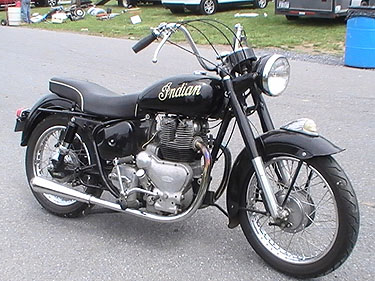
Click on the thumbnails to get big views of the engine (which is a wet sump
Royal Enfield, quite powerful). The bigger image will open in a new browser
window which you can click off to return to this page.
Here is an ad also from the now defunct Cycle magazine showing the entire line for 1959?? Note that it uses "Enfield" in as large a type size as "Indian". Again check out www.re-indian.com if you need Indian (not Enfield) parts for these bikes. If you need the Enfield components for one of these bikes go to Burton Bike Bits or Hitchcocks in Britain. And join the REOCNA if you live in North America.
Note the trike in the lower right. This was sold to auto service stations and police as the replacement for the Dispatch Tow. (Similar to the Harley "Servi-car"). Whereas the Dispatch Tow tricycle was powered by a flathead V twin engine, the 1955-60 version used a 350 c.c. Royal Enfield OHV single. In Canada this three wheeler was marketed as a Pashley until about 1970 when Enfield ceased to exist. There was always one on display at Firth's Motorcycles in Toronto, but I think I only saw one on the city streets (used by a parking enforcement junior cop to hand out tickets). Actually 52 were sold to the Toronto Police force. Because the force back then had Harley 1200 c.c. foot clutch/hand shift bikes (for both solo and sidecar use), the Pashley had a similar gear change setup so riders would have control consistency. (The police in Toronto were never trained on hand clutch/foot shift until 1980 when Harley finally abandoned the "handbanger" setup after 1979. Seems the reason Harley finally quit making the so-called "traffic special" setup was that by the late 1970's Toronto was the only police force who still demanded it, so it was not worth it for H-D to keep making the foot clutch/hand shift setup solely for that one customer.)
The Enfield arrangement went on from 1955-59 (+ to at least mid 1962 for the Chief only), and below are typical ads from that era. Note the attempts to Americanize the Royal Enfields with Indianesque names.
Black and White photos below are from the March 1955 issue of CYCLE magazine, and show the 250 c.c. single cylinder OHV Fire Arrow and to the right the 500 c.c.twin cylinder Tomahawk. Both are Royal Enfields dressed up as redskins.

Also from a rally I was at, namely Mid-Ohio around 2015, a Fire Arrow
that has been tastefully made to look like a more modern (1960's era)
off-road bike:
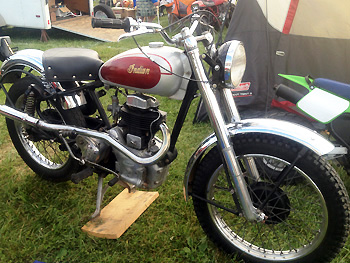
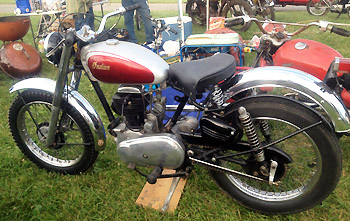
Also imported from the UK was a 250 single flathead (called the "Brave")
for buyers on a budget. Below are two shots of a red 1956 Brave, expertly
restored.
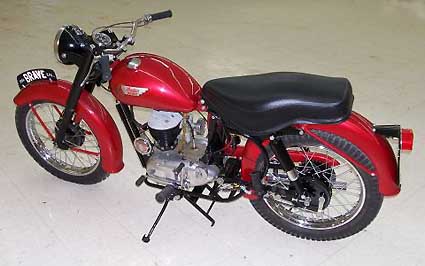
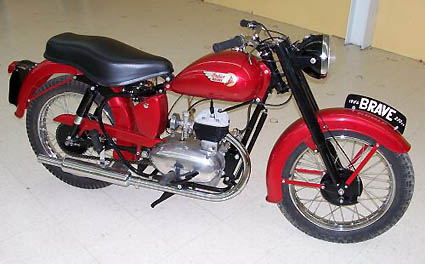
I get so many e-mails from readers with 250 singles and Taiwanese motorbikes
(50 - 175 cc.) thinking that because it says INDIAN on the tank they are worth
a lot. Sorry, they are not worth much at all, even in perfect condition. The
Royal Enfield powered 500 c.c. singles and 500 and 700 twins are worth something
to fans of Royal Enfields (join the R.E. Owners Club of North America to get
a sense of values in the club newsletter). Nothing like the $25,000 - $35,000
well restored 1945-53 Chiefs are now commanding.
As alluded to above, in 1959 a new Chief was offered, being the 700 c.c. Enfield engine in a stretched frame with semi-valenced fenders, 16" wheels, and a specially made heavy duty gearbox never used before or after on any Enfield except for the Apache models of the same years. (Many if not most of the Chiefs were sold as police versions with sirens and red spotlites and Harley/Indian style solo saddles with a plunger rod mini-suspension at least as shown in the ads. They were called Police Chiefs, a bit of a pun). Apparently these bikes were made in 1958, 59 and '60 and sold as 1959, '60, '61 and leftovers as 1962 models. Below are several shots of this 1959-62 Chief in police and civilian trim. Not quite as beautiful as the 1940-53 skirted Chief but a close second. The acceleration and top speed were as good as if not better than the earlier V-twin flathead Chiefs. These 1959-62 Chiefs were considered almost worthless at the end of the 20th century but now perfect restorations are going for up to $10,000 US.
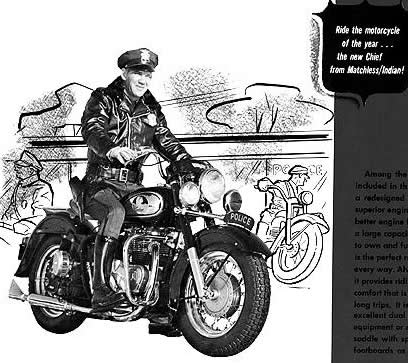
The ad below says there's only one Chief, (at least there was no Matchless 650 Chief) but lots of readers would have remembered the flathead V-twin Chiefs of seven years previous. I have even seen photos of flathead V-twin Indian Chief engines stuffed into 1950's and sixties Matchless motorcycles, (see the Customs page of this website) done so neatly and professionally that one wonders if they were done by factory staff as official prototypes using new old stock Chief parts. In fact the owners think so. Equally likely they were done by Indian dealers who did not like the Matchless engines, but it is a mystery. The very reliable understressed Chief engine would have put out as much power as the athletic Matchless unit (which had a reputation in the 650 cc models for exploding it's bottom end), but would have the great English gearbox and frame and 150 pounds less weight. Location and drive to a generator or alternator would be problematic but not insurmountable.

Below are shots of three civilian (non-police) Chiefs. The blue & white one
is a 1959 model and was sold on Ebay late 2007. The dark red metallic one with
original paint is a 1960 Chief and was offered for sale in late 2007 and
eventually sold by michaelsmotorcycles.com The third 1960 Chief in tasteful
green was on Ebay in April 2014. Lastly there is a very pretty burgundy and
white 1959 or 60 Chief.
 |
 |
 |
 |
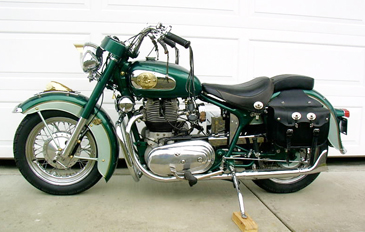 |
 |
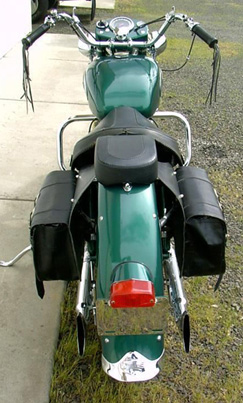
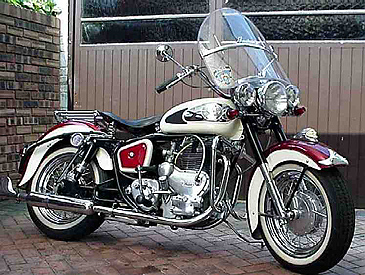
The red one below is from Ebay circa 2009.

Next we have some shots of Christi of Nevada who has a 1959 RE Chief as well as a 1946 American Chief.



In 1960 the Indian Sales Co. was selling Matchless 350 c.c. single cylinder
models (so-called "lightweight" series) as evidenced by the two ads
from Cycle of that year showing Ohio dealer Dick Klamfoth who raced and won
on that type of bike.


Indian did not try to dress the Matchlesses up in Indian colors as it had done with the Royal Enfields; nor did it bolt the Chief's head to the front fenders, but starting in 1961 it gave the Matchless bikes Indian names. To try to fool or at least appeal to the customers, it used mostly the same names as it had applied to the Enfield series. See 1961 ad above with Tomahawk, Apache and Trailblazer. Below is page 2 of a two page ad from 1962, showing several Matchless models with Western names such as Apache and Pathfinder. (Page One, not shown, showed bikes named Mohawk, Pinto and Papoose.) This fake consistency in nomenclature must have been confusing for everyone, especially for parts orders, as a customer with a 1961 or later Trailblazer owned a Matchless 650 whereas one with a 1960 or earlier Trailblazer owned a Royal Enfield 700. Likewise a Tomahawk was really a 500 cc. Matchless starting in 1961, but really a Royal Enfield 500 from 1955-60. Similarly an Apache was first a 700 c.c Enfield; later a 650 c.c. Matchless! Speaking of Matchless, the famous G-50 OHC 500 single racer above was marketed as a street bike called The Golden Eagle. Note how the ad is mostly Matchless but the Indian name and logo and the Indianesque model names were still used to imply that these British bikes were also Indians.
All of the early 1960's ads and sales must have been good news to Matchless and AJS fans, who now had a big distribution network for sales and service, but it must have been disappointing to fans of the all American Indians who loved the V-twin Chiefs and Scouts.
By 1960 the arrangement with Enfield was ending and as of 1961 Enfield began to market their own bikes as Royal Enfields, with no modifications to the UK models. No longer were they painted red, given Indian-esque names, having the Indian script painted on their fuel tanks and the Indian Chief's head running lamp bolted to their front fenders. (Apparently except for the Chief in 1961.) They went back to being the sports bikes they were sold as in Britain. What was the Indian company going to do? They became, or reverted to being, the North American distributor for the Matchless and AJS brands. But they still had some Enfield powered bikes in inventory to sell, so in advertisements what the reader saw was the Indian+Matchless logo, but with photos of Indian-Enfield bikes for sale! Then in 1961 the same ads had both the Enfield powered Chief and some Matchless models. This made sense for the Brockhouse Corporation as it had a good model range (350, 500 and 700 c.c. by Enfield, 650 c.c. by Matchless.) One would think from the ads that the big Chief was a Matchless Indian whereas it was an Enfield Indian. Meanwhile in every other country Matchless and Royal Enfield were two different and competing companies (although often sold by the same small dealers). However the Indian company's reversion to selling Matchlesses only lasted for three years, as AMC (owner of Matchless) began to go bankrupt in the UK and cancelled the deal circa 1962 preferring to use the Berliner network which was doing well with Norton.
Although 90% of English bikes in the late 1940's and in the 1950's were sports bikes, there were a couple of tourers which competed with Harley and Indian. These being the Vincent Rapide and later the fully enclosed Black Knight (61 CID or 1000 cc), the Sunbeam which was like a BMW but with two inline cylinders (reliable and had 5" X 16" wheels and fat fenders, but the engine was only 30 CID or 500 cc so it didn't last long) and the Ariel Square Four (61 CID or 1000 cc). The "Squariel" is shown below left and the Sunbeam is on the right. Of the three, the "Squariel" was the most successful but it disappeared in 1959, the same year the new Indian Chief came out. Ariel made the same fatal error as Indian, cancelling their steady selling big models and abandoning that market in favour of new lightweights which flopped. Honda soon got that market.
Part of the trend toward lighter, faster, better handling and shifting motorcycles was due to American soldiers and pilots in WW II being stationed in Britain and getting exposed to the English bikes which were so much more advanced than the Harleys and Indians back home. (Of course they were mechanically unreliable, had very unreliable electrical systems and fast-wearing carburetors, were prone to oil leaks, clutch problems and snapped clutch and brake cables, vibrated badly and were overall very uncomfortable on the highway, but this may not have been noticed much during short trips in a small country with plenty of curves and no superhighways.) Basically the huge V-twin tourers (or cruisers) are best suited to North American roads while the Limey bikes were best suited to curvey trips of shorter duration, i.e. British terrain. It is just as inappropriate to expect a British 500-750 cc bike to be a good expressway cruiser as it is to expect a big Harley or Indian Chief to go fast on curvey roads. (The author has tried both forms of folly, so speaks from experience.)
Sometime between about 1955 and 1965, a former race and Indian dealer named Sammy Pierce in California made great efforts to revive the marque. He built about 50 bikes from NOS parts, all of them different from each other, sold under the name "American Indian" or "Super Scouts". You can see photos at www.indianscoutmotorcycles.com .By the 1970's they were being cannibalized for parts for stock Indians, but a few survive unmolested. These specials usually had a Torque series rolling chassis (1949 Scout/1950Warrior), with 750 cc Scout or 500 cc Pony Scout (or military 741) engines crammed in. The engines were reportedly souped up and bored out but you can't expect much from a V twin flathead of around 500 c.c. or so. Pierce was famous for popularizing the phrases "You can't wear out an Indian Scout and you just can't beat an Indian Chief", and "Harley Davidson made of tin - ride 'em out and push 'em in".
In addition, Sammy Pierce and Ed Kretz and friends collaborated on a bike
called the P-61 Rocket. It had an Indian 841 frame (plunger rear suspension) and
an engine that was externally a combination of Scout and Chief parts. The fork
was from an Ariel. Inside were combined plain and ball big end bearings, the
theory being that if one type failed at high rpm the other would carry on. Given
that these were side valved engines with no more than 1000 c.c. one doubts they
could reach 6000 rpm. The bike could not even reach 100 mph, yet a steel band
was pressed around the flywheels "to keep them from disintegrating at high rpm"!
The obsession with steel bands also ran to the Scout rear brake drum which had a
band pressed around it to keep it from distorting under hard use. All this
despite the makers claimed obsession with light weight. Big end and flywheel
failure is unheard of in Chiefs and Scouts so why these "improvements"? Parts
from Ford, GM and Chrysler cars were used in the engine and brakes. Although
this was a sport bike (a this time fat tourers were out of favour with the
general riding public), a massive skid plate covered the engine and gearbox.
More excess weight! One more realistic improvement was that the engine was
rubber mounted, although my experience on flatheads is that they don't vibrate
much anyway due to low compression. Suspiciously despite all the boasting of the
advances in the "Rocket", not a word was said about the gearbox or clutch, and
it is not clear from the photos (below) whether it was foot or hand shift. One
can see a clutch lever on the left handlebar and no sign of a hand gearshift
lever so perhaps an Ariel or Triumph gearbox was used. But then the kick start
mechanism looks stock Chief, and the gizmo on the outer end of the clutch derby
suggest an Indian 3 speed or more likely H-D "45" 3 speed gearbox. Also, the
fact that the final drive chain is on the right hand side is a dead giveaway
that the gearbox is either Indian, H-D 45 or K or Sportster. The final
eccentricity about this bike is that it had a big Oldsmobile horn. Perhaps a
large car horn was needed because the designer chose to mount the horn inside
the large headlamp nacelle where a small motorcycle horn could not be heard!
Doubtless this huge horn added more weight. Despite its eccentricities, the bike
does look exciting. The styling is a weird combination of traditional American
(tractor type solo saddle with ornaments, speedometer mounted on the fuel tank,
sidevalved engine of 1930's heritage) and modern (frame and possibly gearbox).
Not surprisingly this oddball machine never went into production.
In the late 1960's another eccentric and flamboyant American former Indian Scout and H-D racer, stunt rider, Indian dealer and for some years owner of Cycle magazine, decided that it was time to revive the Indian brand. The Matchless/AJS brand (along with Norton and Guzzi) were by then being marketed be a company called Berliner and the Indian distribution network had ceased to exist. Indeed the Indian name had disappeared during the decade except in California where Sammy Pierce kept trying to revive it. And like Sam Pierce, Mr.Floyd Clymer's aspirations exceeded his finances. Clymer planned to revive the famous and still lamented flathead V twin Indian Scout using a frame by German eccentric Mr. Friedel Munch (Munch had already squeezed a modified NSU car engine into his own rolling chassis and called this huge beast, aptly, a Mammoth - at the time it was the biggest bike one could buy.) For the revived Indian Scout although the frame, forks, wheels and brakes would be closely based on the Mammoth and thus be state of the art (for 1967, including electric starting and twin disk brakes at the front or as an option the Munch front brake as shown in the photos ) Floyd wanted to use the original Scout sidevalved engine. He thought there was still a demand for the 750 cc flathead Scout and was sentimental about them. Supposedly the engine was to be updated based on a Big Base Scout racing spec engine, but other than magnesium instead of aluminum, and a 4 speed foot shift/hand clutch gearbox it looked like a stock 1940's Scout engine. (See photos below.) It seems to share the front end and rear body parts with the Mammoth but had the old Scout engine - even had the old Linkert carburetor although production versions were meant to have a Dellorto. This bizarre combination of decades old engine and new rolling chassis never got past the prototype stage. Cost estimates to manufacture it for a profit showed it economically unfeasible. Sadly Clymer died in 1970 and his Indian revival dreams died with him. In late 2009 the prototype was sold for a lot of money to someone who can make it into a running motorcycle if anyone can. So the 1968 Indian (which was still being promoted and advertised in 1969) was stillborn.


Since it had only been less than a decade since the Royal Enfield 700 cc. powered Chief, Floyd's next idea was to contact the Enfield company about buying engines. By then it was 1969 and their big twin was 750 cc and somewhat faster and considerably improved over the earlier 700 cc version. Enfield were happy to sell engines for the new Indian. As for the rest of the machine, unlike the 1959-61 models, it was not going to be called a Chief and would be a sport bike. Instead of being a Royal Enfield made to look Indianesque, it was going to have an Italian frame and sheet metal. The Italjet company agreed to supply the rolling chassis. The result was a bike even sportier and better handling and braking than the Royal Enfield. Sometime after 1970 some points covers with the Indian script on them turned up in England, obviously designed to be put on the Indian Enfields, but not ready in time.
It was beautiful, in the sportbike rather than big fat Chief style. Sadly,
Floyd died in 1970 just when the project was getting rolling and very few were
made (between ten and a hundred; about 15 are known to still exist). Below is a
black and white photo of one, note they apparently came with two fuel tank
styles. Compare the B&W prototype to the green one owned by Joe Pasquale. Joe
seems to have removed the oval disk from the side panel which is fine since whoe
needs a place to attach a racing number on a street legal bike?

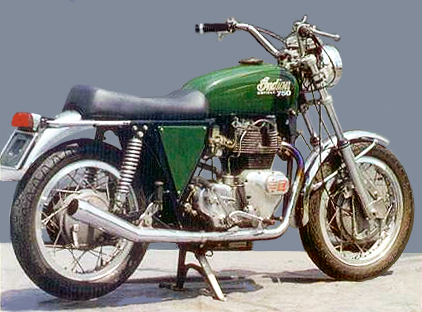
Next we see a red and white one that is or was owned by Joey MacArthur of sales@motodeals.com in the USA. It was for sale a few years ago for offers above US$16,500, which probably barely covered the cost of restoration. It took a decade just to get all the parts. If I had the $ I'd snap it up.
 |
 |
 |
 |
 |
Jumping back about two years for a moment, Clymer also planned to use Horex
(German) parallel twins as a stop-gap until the 750 Enfields were ready, but it
appears that only one or two prototypes of this bike were made (see below):
Specs for bike in color are: 600cc, chain driven OHC, 4 speed, unit
construction, Bing carb, Bosch electrics, Boranni rims, Magura handlebars and
controls, speedo & tach, Ceriani forks, optional Campagnola disc brake,
Available Feb. 1969 for US$1,750

Returning to 1969/70, another idea of Floyd's was to make an Indian 500 single with an English motor. Wasn't this just what had been done in the 1950's? Yes but instead of painting a Royal Enfield 500 single red and calling it an Indian, the 1969 and 1970 version was an English Velocette 500 single in an Italjet frame. (Looks to me that the complete frame, wheels, sheet metal and perhaps wiring were Italian and only the engine and gearbox and primary drive were British.) These are also rare but I have seen one or two running (well) at vintage rallies. Even if the project had not ceased with Floyd's demise it is unlikely it would have taken off as the few Velocette fans (Velocette was just about dead in 1969) would only have bought the bike as a Velocette and old time Indian fans would have had no interest. I still wonder why Clymer didn't use the Royal Enfield 500, given that he bought 200 Royal Enfield twin cylinder engines, as it was still being produced. In fact it was part of the Enfield Indian line 1955-60 (called Woodsman and Westerner in the ads above). As a footnote, the Royal Enfield 500 single is still being sold today, in India (where it is now made and had been under licence from Royal Enfield since about 1955), England, and the USA. Possibly the Velocette engine was considered more sporty and popular circa 1969. Possibly Velocette offered Clymer a lower price than Enfield, or possibly production of the Enfield singles had been totally shifted to Madras, India by 1969. (India was too far away and the quality of the Madras Enfields until recently was a far cry from those made in England.) At any rate the new bike came with a Velocette engine and testers say that the Italian frame greatly improved the handling, and the Grimeca brakes were much better too. Of the 97 built, about half had the 41 h.p. Venom Thruxton engine, compared to the stock 34 hp Venom engine. So perhaps the Indian Velo with the Thruxton version of the engine is one of the best 500 single sport bikes of the pre-Japanese era. Below on the left in B&W is a Clymer advertising photo of a prototype and below on the right in color is a photo of Tim Switter's, purchased from John Cooper. It is a 1969 with the 34 hp mill. The headlamp mounts are longer than stock, rear dampers are aftermarket and seat has extra padding. Ignition key has been relocated and electrics converted to 12 volts.

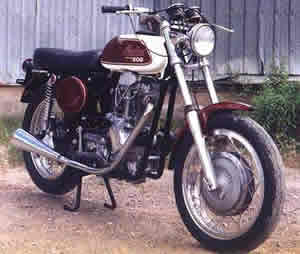
Below is an article about these Velocette Indians from the long defunct Cycle Guide magazine, Dec. 1969 issue. Click on the small icons to open each page in a new browser window, image size will be 700 pixils wide so you can read the text. Your browser may reduce them which might make them fuzzy so try to set it to VIEW "actual pixils".
The last Engish powered bike by Clymer to wear the Indian logo is the most mysterious. Only one prototype was made, shown below. This was a Norton 750 in an Italjet frame. The disk brakes are Campagnolo, cable operated. The same Italjet fenders seen on the Horex-Indian and with a BMW headlamp (my 1970 Italian Laverda had one), and a custom fuel tank. A beautiful sports bike. Thanks to Phil Doland for the info. Hopefully this "Nortian" or "Indiaton" still exists. If so, whoever owns it (or anyone with a better or more photos) please come forth and take a bow as the owner of one of the rarest post 1953 Indians.

Now we move on to yet another chapter in this fascinating saga. With Floyd's death his wife and estate were not keen to continue the project, and the freight forwarding company (which the estate trustee would not pay) had 200 Royal Enfield 750 c.c. engines sitting on some US dock. The famous Rickman frame company of England was contacted and an agreement came to be resulting in 200 Rickman Enfields. These are valued by collectors and are a great sportbike (by 1970 criteria) but personally I consider them ugly and prefer the Clymer Enfield Indian with its Italian styling and Grimeca brakes. The Rickman Enfield Metisse was 100% English, both in engine and in frame. I have not put a photo of the Rickman Enfield in this site because it was never marketed as an Indian. Anyone with a Clymer Indian is encouraged to contact Phil Doland at phildd@burwood.hotkey.net.au as he is creating a registry. He owns a '57 Indian Woodsman, '59 Chief, a (Clymer) Indian Velocette and a (Clymer) Indian Enfield 750, so is the ideal person for this self-inflicted task.
www.re-indian.com is another useful site for info and the owner makes repro parts for the rare 1955-61 Royal Enfield-Indian hybrids.
According to Classic Bike magazine, (Dec. 1993 issue from where the following photo was taken, with thanks), the penultimate chapter of the story was in 1974 when Floyd Clymer's lawyer (who owned the Indian name and logos) tried to interest Ducati in reviving Indian with this joint project bike. Apparently lawyer Alan Newman shared Clymer's dream and a few years after Clymer's demise, with ideas of sport engines in Italian frames still in his head, but with the English companies except for Triumph having died out by then, why not an all Italian engine and frame but American styling. Thus was born a Ducati chopper with Indian logos! At least two protoypes were made (see photos) but it never went into production.

Probably inspired by this, Cagiva came out with a similar bike in the mid 1980's basd on the Ducati Pantah 650. (See article in Motorcycle Classic.com .) Looks like it was intended not to revive Indian despite the same name "Ducati Indiana" but rather to compare with the then popular Yamaha Viragos. (Used to see so many of the Viragos- where did they all go?)

Mr. Newman was also a pragmatist and saw the market for mini-bikes, and
still owning the Indian name and logos he contracted with a manufacturer in
Taiwan to make Indian mini-bikes from 1971 through 1976. Indian had their own
factory in Taipei, and used Minarelli, Morini and Fuji engines of 50 c.c.
through 175 c.c. Early models were called "Indian Four", trying to cash in on
the fame of the prewar Four, but actually referring to 4 stroke engine rather
than four cylinders.) Likewise there was an Indian 80, only 80 cc. but pehaps
trying to rely on the cache of the famous Indian 80's of 1950-53. Sales were
good in the beginning, with over 20,000 sold during the 1972/73 season. In Jan.
1977 the Indian name was sold to American Moped Associates, who continued to use
the plant in Taiwan until about 1982 when they sold out to Mr. Carmen Deleone
(who is mentioned elsewhere in this website). As a result, Manco go-karts were
made with the Indian name on them for a year. To your right is a photo of a
1978-82 made-in-Taiwan Indian which I took at a rally in the year 2000. It says
Four Stroke on the side. I often get emails from readers who own these 1971 - 82
bikes thinking they are worth a lot because they say "Indian" on them, but
really they are worth very little - few hundred dollars max unless you can
sucker a museum into buying one- so please stop sending the emails. For more
details on the Indian mini-bike era see
http://clubs.yahoo.com/clubs/the1970indianmotorcycle , and thanks to their web
author for the above info.
To conclude this section, many will say this 1950-60 and 1970's business was impure, "not real Indians", but the 1999-2003 Indian Chief had an imitation Harley Evo engine and gearbox and clutch and primary drive, in an imitation Harley Softail (TM reg.) frame, and the same forks used on Harleys (all made by Showa in Japan), so if a 1960 or 1970 Indian is not a real Indian one could argue that neither was the 2000 model. The 1960 700 cc. vertical twin Chief, the 1970 500 cc.c single and 750 c.c. vertical twin Indians, and the 2000 V-twin Chief were all made under the design and orders of the people who at those times held legal title to the Indian name, so they are legally Indians even if they have engines and frames made by another company. Harleys - I believe - use Japanese forks and partial electrics, and brakes and possibly clutches, and they paid Porsche to design their Evo and V-Rod engines, so what is "pure American" anymore? The big Honda models are built 100% in the USA, by Americans, and Americans had a lot to say in their design, so is a big Honda a Japanese bike? The Honda Aero and ACE Tourer looked more Harley than Harley! And I have heard that at least some of the new Triumph bikes are built in Singapore so does that make them not English? The Royal Enfield singles (also touted as "English" have been made in India since the mid 1950's. We live in a global world of multi-national corporations.
THANKS TO EVERYONE WHO HAS SENT PHOTOS OF THEIR INDIANS, STORIES, INFORMATION and CORRECTIONS. New material is always welcome and appreciated. If anyone recognizes their bike in this site please let me know so I can put your name in as owner. email author and web designer
This site is not the official site of the makers of the current lines of Indian motorcycles, POLARIS INDUSTRIES (V twins in the USA) - They are at www.indianmotorcycle.com - nor INDIAN MOTORCYCLE LTD. (4 cylinder in Edinborough, Scotland)